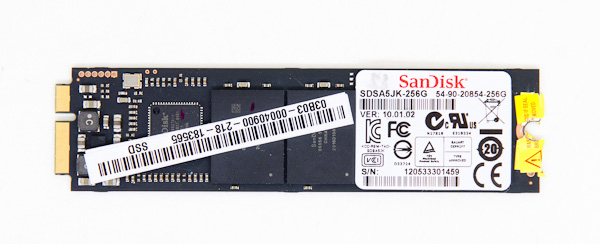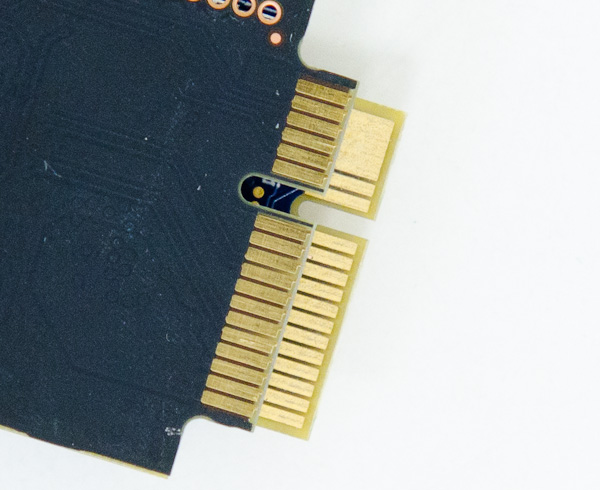ASUS' Zenbook SSD and Apple's MacBook Air SSD Are Not Compatible
by Anand Lal Shimpi on May 23, 2012 2:16 AM EST- Posted in
- Storage
- Mac
- Apple
- MacBook Air
- Laptops
- Zenbook
- Zenbook Prime
- Ultrabook
In working on yesterday's Zenbook Prime review I ran into a problem with the 256GB Sandisk U100 drive that came with my review sample. Unfortunately, since the drive doesn't use a common form factor or physical interface I was limited in my ability to diagnose the problem. Luckily I happen to have a handful of Zenbooks around the lab, one of which had a 128GB U100 that I could swap in, allowing me to complete yesterday's review. I'm going to carry the dying 256GB U100 with me to Taiwan in a little over a week to hand off to ASUS for some forensic analysis.

The Sandisk U100, a poor performer but the only option in the Zenbook Prime
While I was trying to diagnose the problem with the SSD I wondered if I could use the Zenbook's SSD in OWC's USB enclosure for MacBook Air SSDs. The OWC enclosure simply routes SATA power and data pins to the MacBook Air SSD connector. The MBA (and Zenbook) SSDs are obviously SATA compatible, they simply feature a different physical (and electrical) pinout compared to the SATA drives we're used to. Both SSDs feature a proprietary gumstick form factor and appear to have a similar connector. Since I couldn't find any info online about compatibility between the two, I decided to do a little investigating of my own.
The standard SATA spec calls for a 7-pin data interface and a 15-pin power interface for a total of 22 pins. The ASUS Zenbook/Zenbook Prime SSD features a split connector with 12 pins on the larger portion and 6 on the remaining - I assume for power and data, respectively. The MacBook Air SSD on the other hand has a 12 + 2 pin configuration, with a large power, ground or non-connected pin occupying the remainder of the smaller part of the connector. It's always possible, albeit unlikely, that both ASUS and Apple settled on the exact same pinout for their interfaces, thus making these two form factors electrically compatible but with slightly different configurations. However if you line up the two connectors you'll see that there are physical differences that preclude using one in lieu of the other:

Zenbook SSD (top) vs. MacBook Air SSD (bottom)
The Zenbook SSD's pins are slightly offset from those on the MBA's SSD. The ASUS connector is also slightly wider, which means that even if you can physically force it into a MBA you risk the pins not lining up properly and shorting something out (assuming the two interfaces are even remotely electrically compatible to begin with, which is a long shot at best). What about the reverse? The SSD in a MacBook Air has a narrower notch than its ASUS counterpart and won't physically install in a Zenbook/Zenbook Prime.
In other words, the MacBook Air and Zenbook SSDs are not compatible with one another. This is most unfortunate for ASUS as Apple already has companies making SSD replacements for the MacBook Air. I suspect that after the Zenbook Prime officially starts shipping we may start to see some interest from SSD makers. Anyone looking to get a head start on the competition should pick up a Zenbook now and begin work on a faster/better alternative to the U100 that's going to be shipping with all Primes.
One last thing, neither of these SSD form factors is compatible with mSATA although they look similar at a distance. mSATA features a wider, double-sided connector with more pins than either of these two options.
















22 Comments
View All Comments
Ryan Smith - Wednesday, May 23, 2012 - link
It really sounds like the SATA committee needs to make a new standard for these devices; but then again it seems like these guys are reinventing existing mSATA sized SSDs because they can.tipoo - Wednesday, May 23, 2012 - link
Apple even has different SATA connectors on their standard hard drives in the iMac which makes upgrades a pain, no surprises that these are proprietary as well. A bit let down with Asus though. I wonder if there are good reasons for it other than making proprietary products.derektrotter - Thursday, May 31, 2012 - link
No, Apple doesn't have different SATA connectors on their standard hard drives in the iMac. They use the standard SATA connector.name99 - Wednesday, May 23, 2012 - link
It's fine to complain that "these guys are reinventing the wheel" but it has happened time and again that the standard bodies simply don't bother to come up with a spec before it's needed.Let's take one obvious example: where's the mini-ethernet connector --- a STANDARD ethernet connector that is much thinner than RJ-45 so it will fit it thin laptops, tablets, phones? Oh, there isn't one? So what is Apple supposed to do if, for example, they want to thinnify the MacBook Pro but still retain gig-ethernet? All they CAN do is invent their own connector.
In this particular case, I'd be interested in hearing the full story here. Yes yes, we are all aware of your conspiracy theories that Apple are the new SONY, who insist that everyone use their special connector. Meanwhile, in the real world
(a) there is fsckall aftermarket in SSDs for MBAs, so it's not like Apple is afraid of people buying a low-storage MBA, taking it apart, and sliding in a larger storage SSD. The population that are willing to take this sort of risk on a device that's so clearly difficult and delicate to open is a few percent at most.
(b) Asus is hardly a large enough company (nor is it in a market) where it can afford to play these sorts of proprietary games
which both suggest that
(c) there is a very real problem with mSATA which means engineers find it worth the effort to pay a little more for something that is non-standard. I could imagine, among other things
- it uses too much power (or equivalents like it has problems going to deep sleep)
- it's too large
- it's electrically noisy, so it's difficult to work with.
I'd be interested in hearing (from INFORMED) commentators why both Asus and Apple felt it's worth the extra cost (which Apple can afford, but Asus can't) to not use mSATA.
Xajel - Wednesday, May 23, 2012 - link
I very liked the new ZenBook Prime(s), specially the 13 incher... but having non-standard thing is bad... I don't know which one is standard the Apple mSATA or ASUS mSATA even thought I think there's no standard yet for such drives, and ASUS was avoiding and possible lawsuits from Apple if they used the same design...but the point I hate it is the hybrid harddrive, I know it's very nice and better than normal HDD, but comparing it to regular SSD will make us liking the SSD more...
I think the best practice is to have mSATA port for the SSD and optional 7mm slot for normal HDD if the user want more storage ( or cheap storage ), so one can have 128GB SSD only for OS and apps, and the 500GB for data...
+ if he doesn't need that much of data, he can use 256GB SSD and get rid of the HDD to save weight.. or better have the space for that 7mm HDD be used for optional extra battery that gives you more battery life !!
IntelUser2000 - Wednesday, May 23, 2012 - link
U100 might be slow, but could be the factor for improved battery life. I'd like a test between Sandforce based Zenbooks and Sandisk based ones to see which ones have better battery life.As for performance, anything first generation Indilinx controller or better is enough. But not all the manufacturers get the power usage, or reliability right.
r3loaded - Wednesday, May 23, 2012 - link
Why the hell do those two companies think they need to define their own distinct standard from mSATA? The drives even follow the SATA standard, it's just the pins that are different.jabber - Wednesday, May 23, 2012 - link
So they can charge you $300 for an out of warranty replacement rather than you buy a OEM version for $75.I had a Toshiba laptop that had a faulty DVD rom/CDRW drive. The OEM cost of a standard replacement was about £20.
However, Toshiba hardwire/reverse the Master/Slave setting on the drives so a OEM one wont work. A call to Toshiba for a replacement drive? £250.00 please!!!!
I told them to go forth and multiply.
Suffice to say I found a solution on the web and used a fine paintbrush and silver paint to connect two pins to reverse the Master/Slave setting.
Torrijos - Wednesday, May 23, 2012 - link
The mSATA standard still (2012.05) hasn't been ratified!So Apple, that has been selling SSD-only MacBook Air since late 2010, or anybody else wishing to set up their hardware with sticks of SSDs has had to setup their own system waiting for the SATA-io to finally get their act together.
Apple MB Air has been a huge computer product for them, so should they have been waiting until the standard is finally ready, or switch to micro-SATA, which limits storage to 64GB soldered on the mother board?
bah12 - Wednesday, May 23, 2012 - link
At first I wanted to blast ASUS for this proprietary card, but there is more at play here. As others have said there is no ratified standard. So ASUS had 2 choices, make their own or copy Apple. I think they did the right thing with the iLawyers on prowl for anything "infringing" these days.